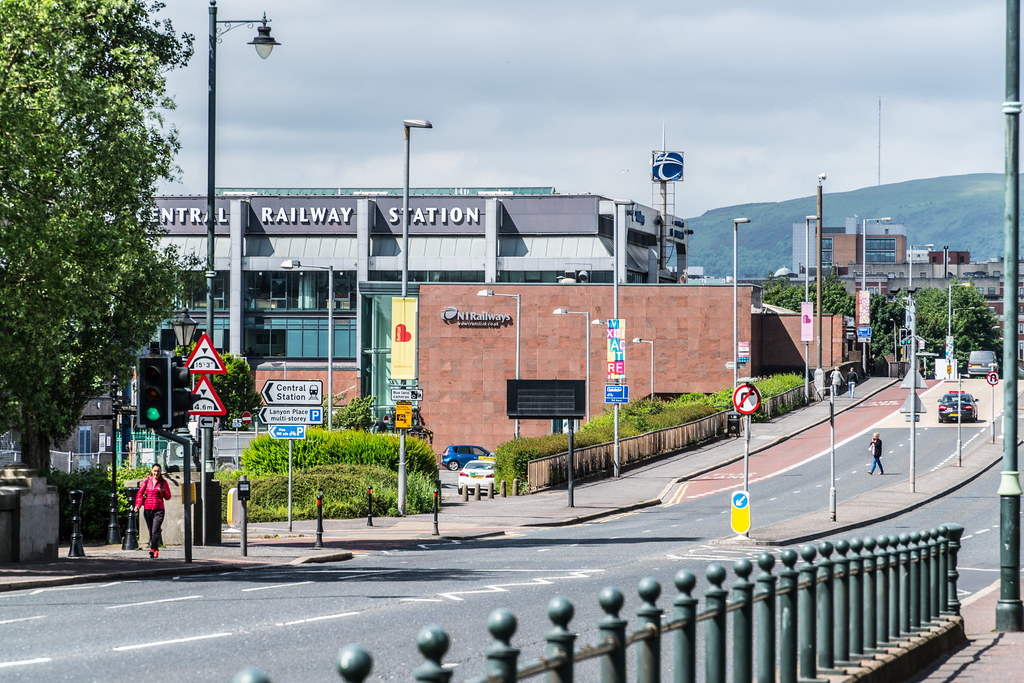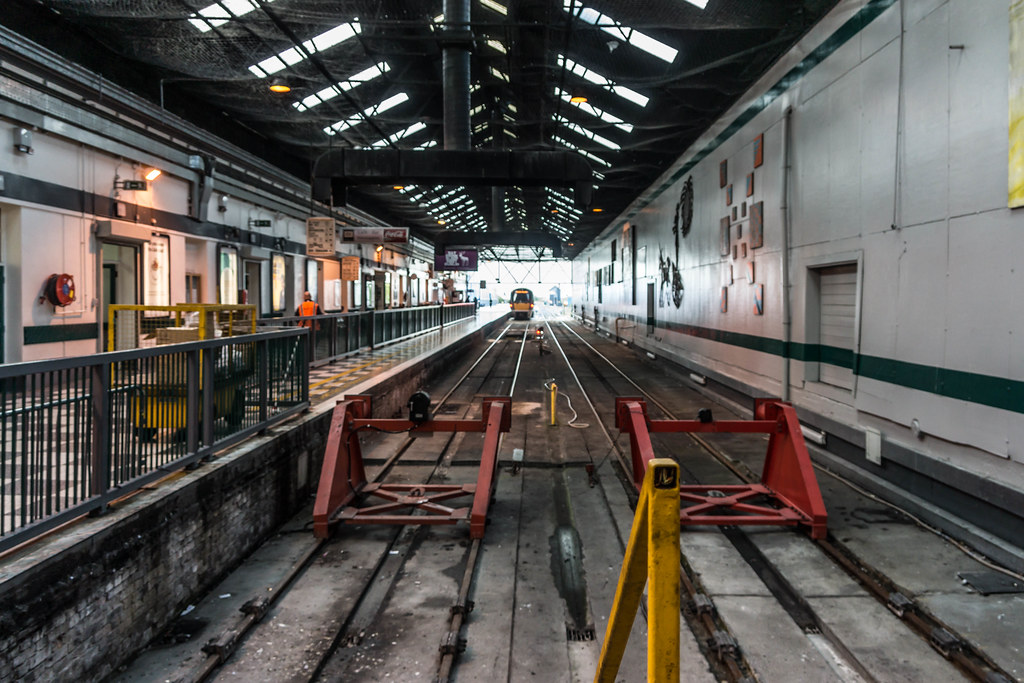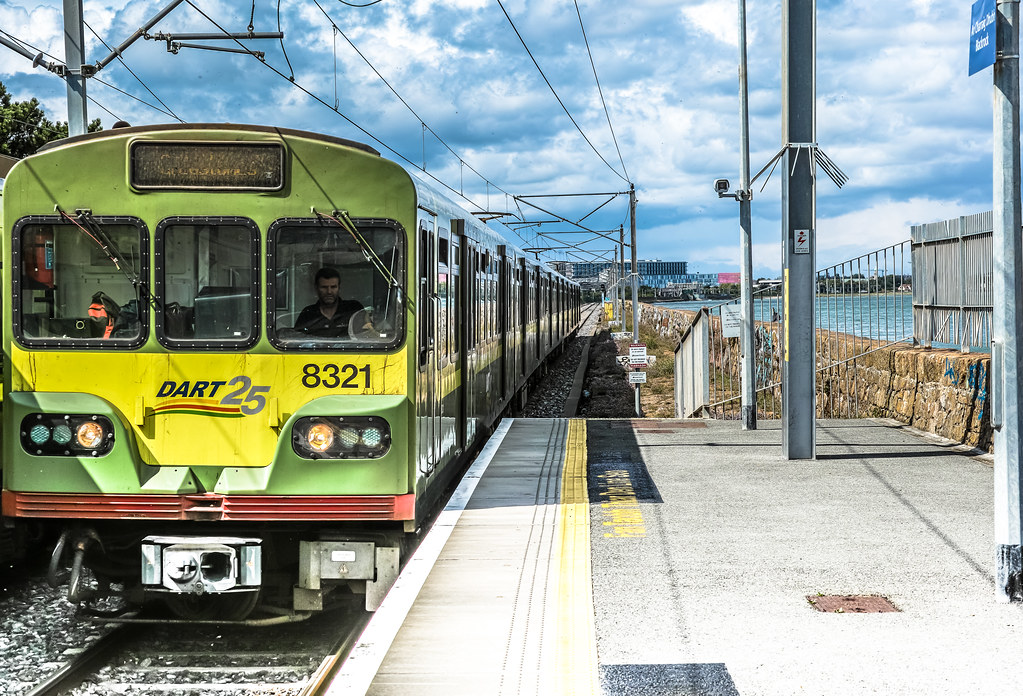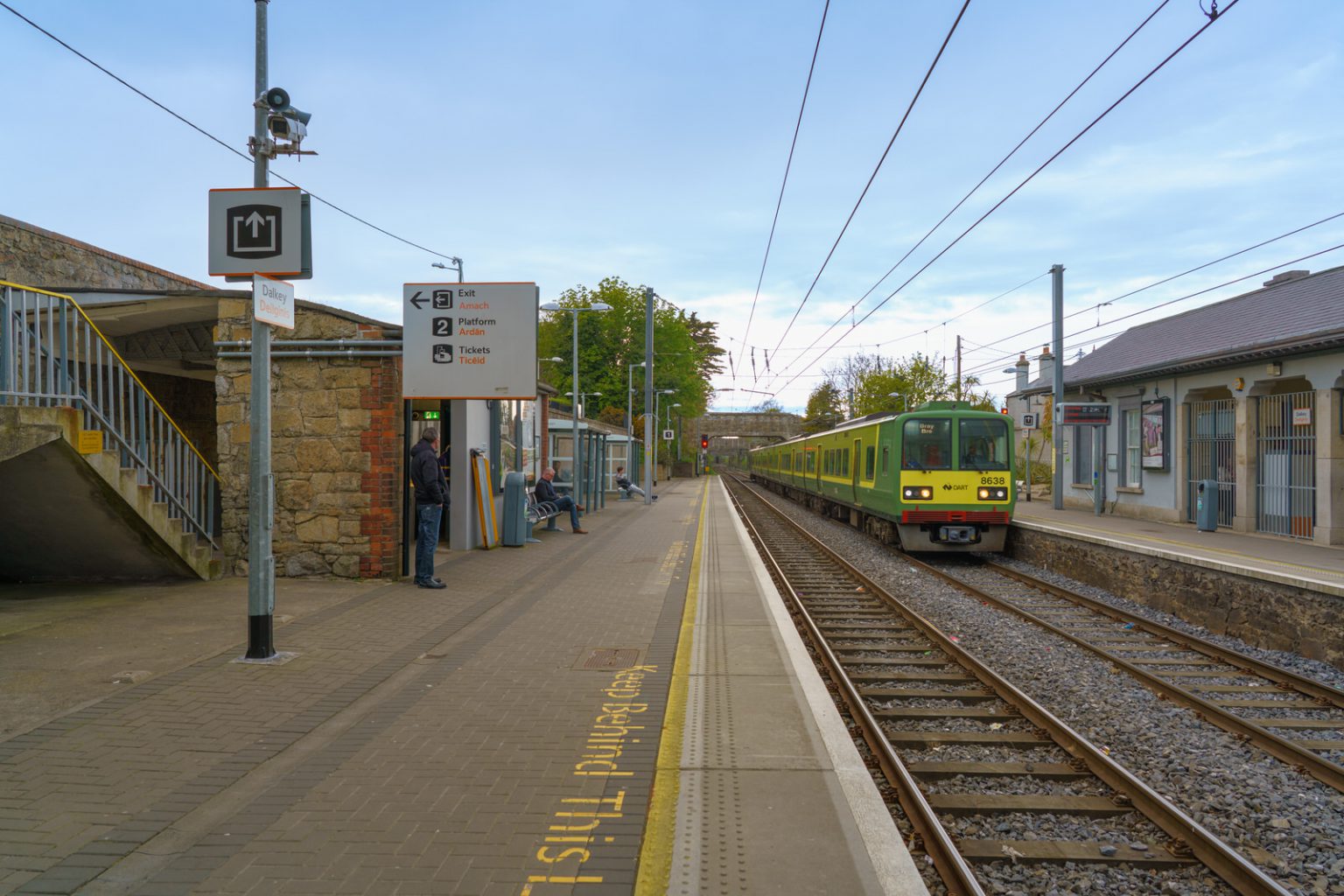
Custom Search
THIS SECTION IS NO LONGER LIMITED TO MATERIAL FROM 2017 OR EARLIER
THE GREEN MENU OPTIONS ARE MOBILE FRIENDLY AND ARE FASTER SO THEY ARE RECOMMENDED. THE RED MENU OPTIONS ARE SOMEWHAT SLOWER DEPENDING ON YOUR DEVICE OR BROWSER AND ARE MORE SUITABLE FOR DESKTOPS AND LAPTOPS. THE BLUE OPTIONS ARE PAGE LINKS AND WILL BE PHASED OUT GOING FORWARD
TRAIN STATIONS IN IRELAND
LOADING
A train station, or a railway station (in Commonwealth English) or a railroad station (in US English) or simply station, is a railway facility where trains regularly stop to load or unload passengers and/or freight. It generally consists of at least one track-side platform and a station building (depot) providing such ancillary services as ticket sales and waiting rooms. If a station is on a single-track line, it often has a passing loop to facilitate traffic movements. The smallest stations are most often referred to as 'stops' or, in some parts of the world, as 'halts' (flag stops).
Stations may be at ground level, underground, or elevated. Connections may be available to intersecting rail lines or other transport modes such as buses, trams or other rapid transit systems.
Stations may be at ground level, underground, or elevated. Connections may be available to intersecting rail lines or other transport modes such as buses, trams or other rapid transit systems.
The world's first recorded railway station was The Mount on the Oystermouth Railway (later to be known as the Swansea and Mumbles) in Swansea, Wales, which began passenger service in 1807.
The two-storey Mount Clare station in Baltimore, Maryland, which survives as a museum, first saw passenger service as the terminus of the Baltimore and Ohio Railroad on 22 May 1830
The joint oldest terminal station in the world (the other being Manchester's Liverpool Road, see below), was Crown Street railway station in Liverpool, built in 1830, also on the Liverpool to Manchester line. The station was the first to incorporate a train shed. The station was demolished in 1836 as the Liverpool terminal station moved to Lime Street railway station. The station was converted to a goods station terminal.
The first stations had little in the way of buildings or amenities. The first stations in the modern sense were on the Liverpool and Manchester Railway, opened in 1830. Manchester's Liverpool Road Station, the joint oldest terminal station in the world (and the only surviving one), is preserved as part of the Museum of Science and Industry in Manchester. It resembles a row of Georgian houses. Early stations were sometimes built with both passenger and goods facilities, though some railway lines were goods-only or passenger-only, and if a line was dual-purpose there would often be a goods depot apart from the passenger station.
Dual-purpose stations can sometimes still be found today, though in many cases goods facilities are restricted to major stations. In rural and remote communities across Canada and the United States, passengers wanting to board the train had to flag the train down in order for it to stop. Such stations were known as "flag stops" or "flag stations".
Many stations date from the 19th century and reflect the grandiose architecture of the time, lending prestige to the city as well as to railway operations. Countries where railways arrived later may still have such architecture, as later stations often imitated 19th-century styles. Various forms of architecture have been used in the construction of stations, from those boasting grand, intricate, Baroque- or Gothic-style edifices, to plainer utilitarian or modernist styles. Stations in Europe tended to follow British designs and were in some countries, like Italy, financed by British railway companies.
Stations built more recently often have a similar feel to airports, with a simple, abstract style. Examples of modern stations include those on newer high-speed rail networks, such as the Shinkansen in Japan, TGV lines in France and ICE lines in Germany.
The two-storey Mount Clare station in Baltimore, Maryland, which survives as a museum, first saw passenger service as the terminus of the Baltimore and Ohio Railroad on 22 May 1830
The joint oldest terminal station in the world (the other being Manchester's Liverpool Road, see below), was Crown Street railway station in Liverpool, built in 1830, also on the Liverpool to Manchester line. The station was the first to incorporate a train shed. The station was demolished in 1836 as the Liverpool terminal station moved to Lime Street railway station. The station was converted to a goods station terminal.
The first stations had little in the way of buildings or amenities. The first stations in the modern sense were on the Liverpool and Manchester Railway, opened in 1830. Manchester's Liverpool Road Station, the joint oldest terminal station in the world (and the only surviving one), is preserved as part of the Museum of Science and Industry in Manchester. It resembles a row of Georgian houses. Early stations were sometimes built with both passenger and goods facilities, though some railway lines were goods-only or passenger-only, and if a line was dual-purpose there would often be a goods depot apart from the passenger station.
Dual-purpose stations can sometimes still be found today, though in many cases goods facilities are restricted to major stations. In rural and remote communities across Canada and the United States, passengers wanting to board the train had to flag the train down in order for it to stop. Such stations were known as "flag stops" or "flag stations".
Many stations date from the 19th century and reflect the grandiose architecture of the time, lending prestige to the city as well as to railway operations. Countries where railways arrived later may still have such architecture, as later stations often imitated 19th-century styles. Various forms of architecture have been used in the construction of stations, from those boasting grand, intricate, Baroque- or Gothic-style edifices, to plainer utilitarian or modernist styles. Stations in Europe tended to follow British designs and were in some countries, like Italy, financed by British railway companies.
Stations built more recently often have a similar feel to airports, with a simple, abstract style. Examples of modern stations include those on newer high-speed rail networks, such as the Shinkansen in Japan, TGV lines in France and ICE lines in Germany.
MALLIN STATION IN DUN LAOGHAIREJANUARY 2023
Also called Kingstown Harbour the station was renamed Kingstown in 1861, and renamed Dún Laoghaire in 1921. It was given the additional name "Mallin" on 10 April 1966, 50 years after the Easter Rising, when Córas Iompair Éireann renamed 15 major stations after Republican leaders. It is named in honour of Michael Mallin, a leader in the 1916 Easter Rising. although it is usually referred to simply as Dún Laoghaire.
THE SECTIONS RELATING THE DALKEYWERE UPDATED 12 JANUARY 2023
Dalkey is a suburb of Dublin and seaside resort just south of Dublin City, Ireland. It was founded as a Viking settlement and became an important port during the Middle Ages. According to John Clyn, it was one of the ports through which the plague entered Ireland in the mid-14th century. In modern times, Dalkey has become a thriving seaside suburb and a minor tourist attraction. It has been home to many writers and celebrities including Jane Emily Herbert, Maeve Binchy, Hugh Leonard, Bono, Van Morrison and Enya
Commercial DisclosurePLEASE NOTE THAT LINKS BELOW MAY REDIRECT YOU TO THE AMAZON LOCATION MOST LIKELY TO SHIP TO YOUR ADDRESS
You will find links to buy products from Amazon, Google and other partners. If you click on these links, you’ll find that the URL includes a small extra piece of text which identifies that the click came from my websites. This text is an affiliate code, and it means that I get a small percentage of the money you spend if you choose to buy that product, or, in some cases, other products from the site soon after. These affiliate links help pay the costs of producing my websites and ensure that the content is free to you.






